Thin Weasel D in Snakewood
(Review written May 2005)
Preface
Glenn Schultz has been making wooden and CPVC whistles for years. He was the mentor of Paul Busman (of Busman Whistles) and the inspiration for Paul's whistles. If you compare the pictures here with my review of the Busman whistle, you'll see the obvious similarities.
I owned a Thin Weasel years ago, which you can see in my old whistle gallery--which is now woefully out of date! Unfortunately, when the Internet bubble burst, I lost my job like so many developers, so I sold the Weasel to make ends meet. Now that I'm doing reviews for my website, I was eager for the opportunity to review a Thin Weasel. Thanks to Glenn's generosity, I got a beautiful loaner snakewood Thin Weasel to review.
At a Glance
Whistle Reviewed: Thin Weasel in D
Models Available: Glenn offers several keys custom made in a variety of exotic hardwoods.
Construction: Exotic hardwood, with stainless steel ferrules.
Price at time of review: $348.00 US dollars (Add $30 for this particular wood, says Glenn, as it's hard to work)
Available From: Thin Weasel Woodwinds and The Irish Flute Store
How Acquired: Product sample from Glenn Schultz
Bottom Line: Moderately loud, nice wooden sound. Big improvements in the 2nd octave and tuning slide.
Appearance/Construction
This is an awesome looking instrument! If my blackwood Abell is a panther, this whistle is a leopard. The snakewood has a nice warm orange-brown color with a highly-pleasing spotted pattern which is really reminiscient of snakeskin. The craftsmanship is impeccable, and the stainless steel ferrules accent nicely.
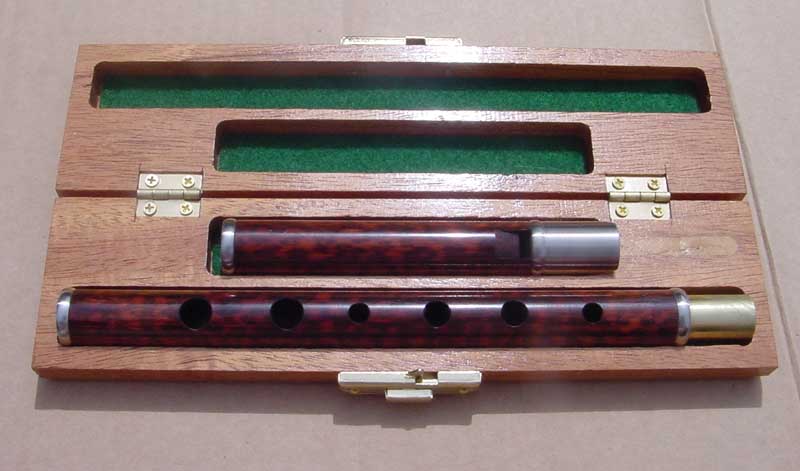
Glenn sends a neat felt-lined box with his whistles. It's a great carrying case, and perfectly fits the whistle. Here you see the whistle disassembled in the box.
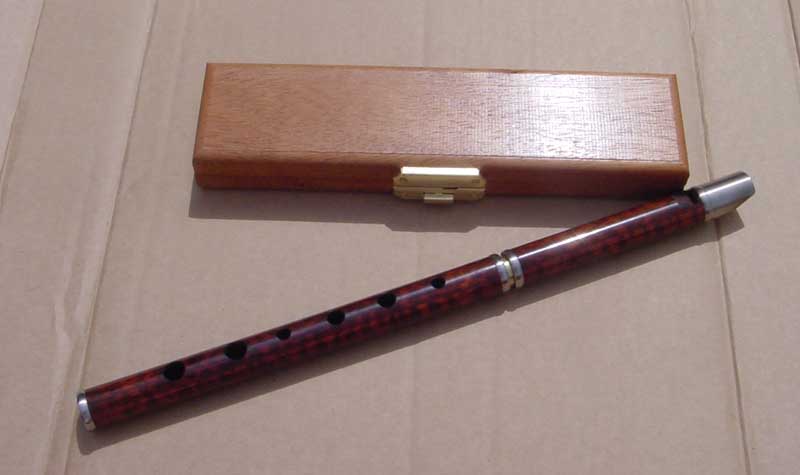
Here's the full whistle, assembled and sitting outside the box. You can see the leopard-spot pattern I mention, but you'll see it even better in close-ups.
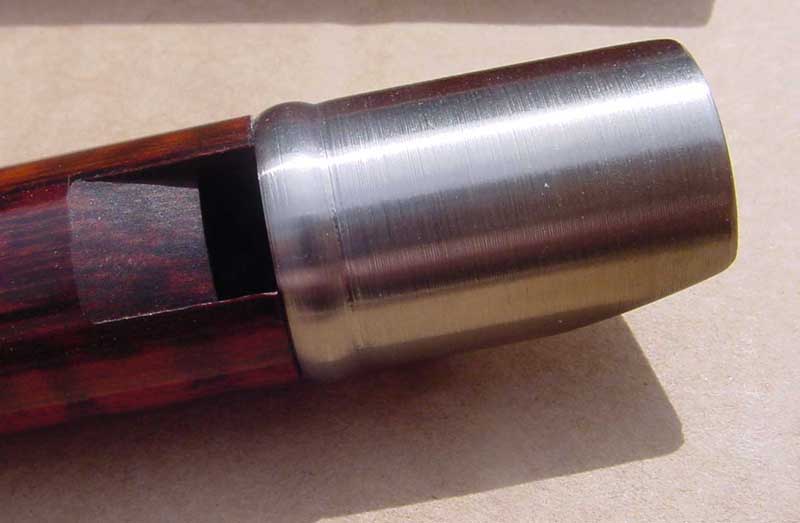
Here's a closeup of the mouthpiece. Everything is extremely well constructed. The stainless steel mouthpiece has an even, brushed finish. The labium ramp is precise and well-formed.
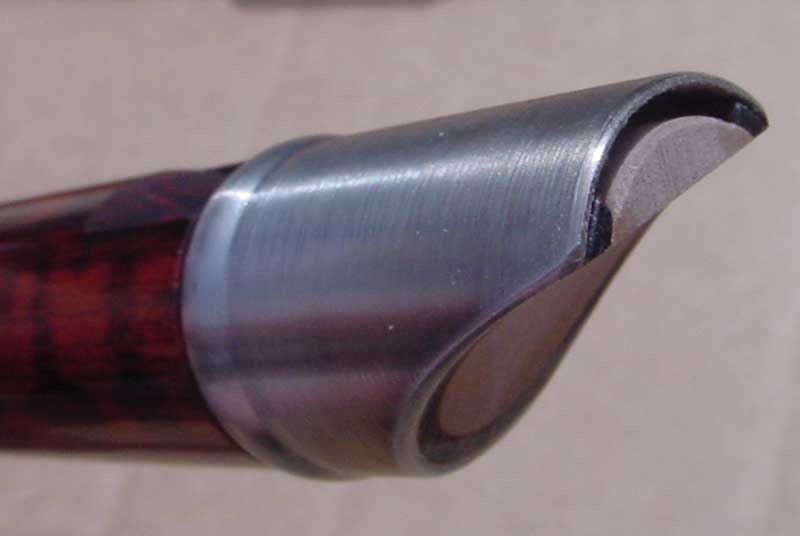
Here's another angle on the mouthpiece, showing the fipple area. Again, the construction is solid and precise.
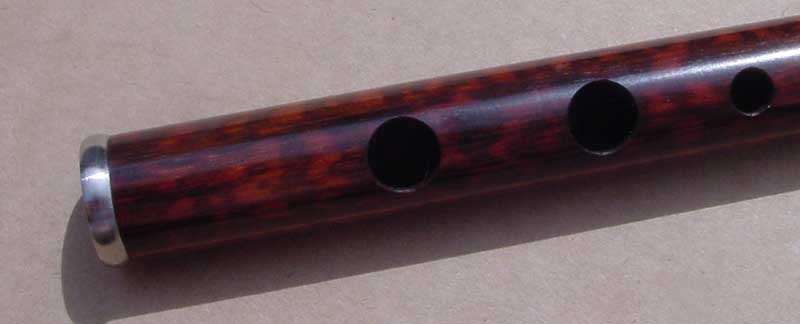
A shot at the end of the whistle, showing the ferrule at the base, as well as the last two holes. The holes on this whistle are smooth, round, and well-centered. Again, everything is amazingly precise. This whistle may cost a little more than some, but you definitely get your money's worth in attention to detail!
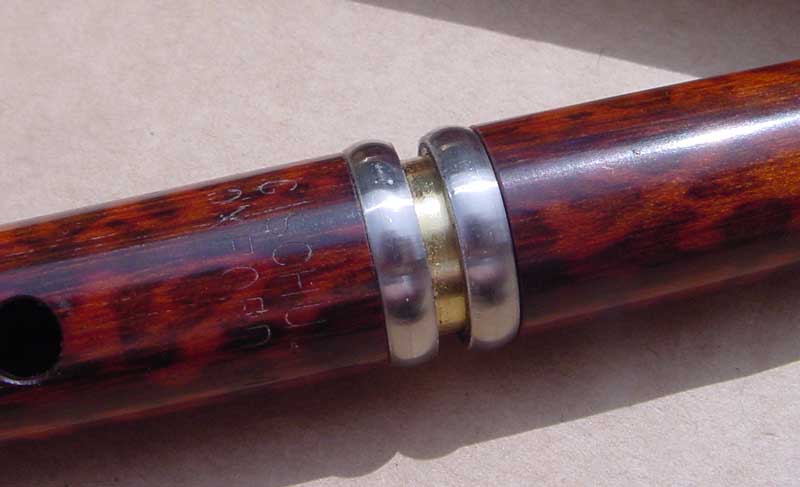
A view of the tuning slide. Here you can see the brass tuning slide as well as the ferrules in this area. At the risk of sounding like a broken record, the workmanship here is practically flawless. Here you can also see Glenn's mark on the instrument: his name and city. This is very lightly done and unobtrusive. I was afraid it might not show up in the photograph. A word about the tuning slide: Glenn has improved it tremendously since I last had a Weasel (or a Busman). The Busman and the old Weasel I had both had tuning slides that were a bit loose. If I got excited while playing, I could easily push them closed, making the whistle go sharp. Glenn has snugged up the slide considerably. There's no way I'll be accidentally pushing this one shut. Glenn did mention that there are free repairs on this instrument for his lifespan, so if your slide goes loose, let the professional fix it!
Playing Characteristics
My old thin weasel was very loud, and took a bit of trouble to hit in the 2nd octave. The newer one is much easier to hit in the 2nd octave, with a small loss of volume. But it's still a faily loud whistle. It's got a very pure sound to it, with no attack chiff (that "ch" sound at the start of a note)and a very slight amount of note chiff (the white noise within a note's duration).
Sound clips of the whistle:
Earl's Chair
Planxty Hewlett
Volume: Louder than average. It didn't quite cut through our extremely loud Friday session like my Copeland or Abell, but it's loud enough to blend in that environment nicely. And you could hear it if you listened for it. For many people, that's the perfect whistle volume for session--at our session, they prefer to hear me much more clearly, and I'm always asked to get out the louder whistles if I'm not playing them.
Responsiveness: This whistle is plenty responsive. Since it takes less attack in the 2nd octave, I can play it much more nimbly up there. I have no complaints with it at all.
C-Natural: OXXOOO produces a C-natural that's right on the money. You can push it a little, about + or - 10 cents.
Tuning: This whistle is in tune, when blown with the proper breath control. The F# requires a little bit of a push compared to the rest of the notes, but the difference is slight, and easily gotten used to.
Hole Size and placement: The holes are well rounded, and centered nicely along the body.
Air volume requirements: Perhaps on the slight high end of average. The takes only marginally more breath than a typical plastic-fippled cheapie. This is different from then first one I played, too..it took a bit more breath.
Air pressure pressure requirements: Like I mentioned above, I expected this whistle to take a bit of push in the 2nd octave. But it doesn't. It actually is comparable to maybe a Clarke original in terms of push required to get it up there.
Clogging: This instrument has average wetness, but never clogged up on me. After 20-30 minutes, the 2nd octave D would get a little touchy (which you can hear in Planxty Hewlett), which would clear up after blowing it out. Since this was a loaner, I didn't play it for hours and hours and get it all clogged with spit. I'm sure it's future owner will be appreciative
Wind Resistance: This is the only area where the Thin Weasel doesn't improve. With reductions in volume, air pressure, and attack, this whistle doesn't stand up to wind as well as my first one. It's quite gusty where I live, and this whistle cuts out on the stronger winds.
Summary
Extremely well-crafted whistle. Glenn's attention to detail shines through his work here, and you get a stable, predictable, well-executed whistle. The whistle has a nice tone, and is easy to play and control. I'm really more than a bit sad that I have to send this one back.